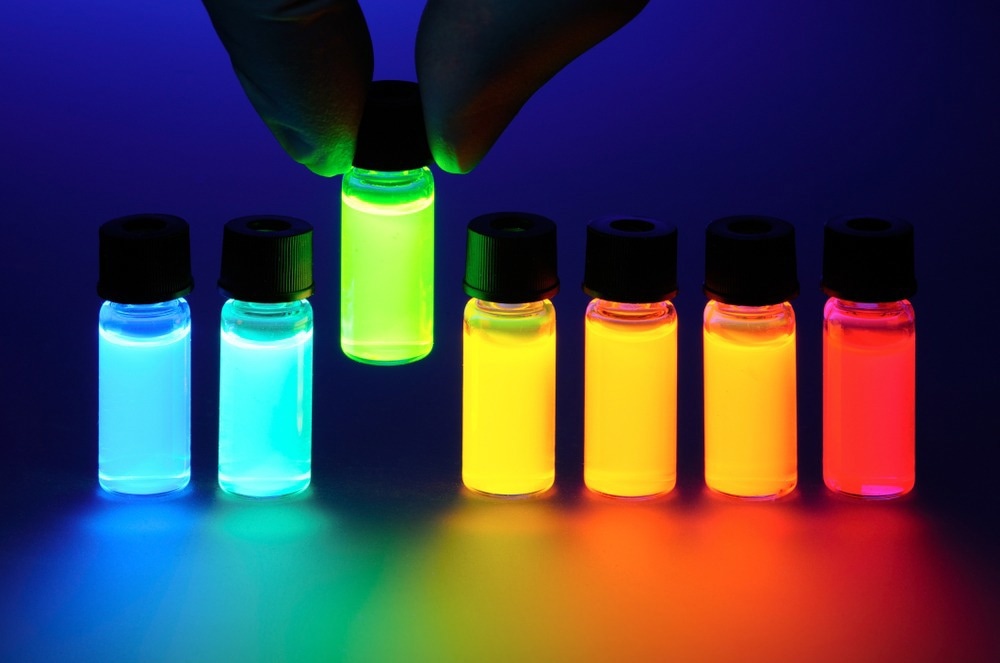Fluorescent sensors are molecular probes that detect and quantify analytes in various settings using the fluorescence phenomenon. They have a broad range of applications in analytical chemistry, biochemistry, and biology because of their excellent sensitivity, selectivity, and simplicity of use. This article explains fluorescent sensors' principles, applications, recent advances, and future perspectives.

Image Credit: Denis Larkin/Shutterstock.com
What are Fluorescent Sensors?
The basis of the fluorescence process is the fluorescence molecule's (fluorophore's) absorption of light at a shorter wavelength, followed by its emission at a longer wavelength. Fluorescence's effectiveness is influenced by several variables, including its chemical composition, the surrounding atmosphere, temperature, pH, and interactions with other molecules.
Fluorescent sensors are made up of a fluorophore and an analyte-specific receptor that binds to the analyte and causes changes in the fluorophore's fluorescence properties. The properties could be its emission intensity, wavelength, lifetime, or polarization, which can be detected and measured using a variety of techniques, including fluorescence microscopy, spectroscopy, or imaging.
Working of Fluorescent Sensors
Depending on the nature of the interaction between the receptor and the analyte, fluorescent sensors may work in various modes. To quantify the analyte concentration, specific sensors, for instance, use a competitive binding mechanism where the analyte's binding suppresses the ligand's fluorescence signal.
Another mode of fluorescent sensor uses an allosteric mechanism, in which the receptor changes its conformation after interacting with the analyte, changing the fluorescence signal of the fluorophore. This method is often used in enzyme sensors so that the fluorescence signal of the enzyme's substrate or product may be used to measure the enzyme's activity.
Applications of Fluorescent Sensors
Medical Industry
Fluorescent sensors have numerous applications in different fields of science. For instance, fluorescent sensors can diagnose and monitor various diseases and disorders, such as cancer, diabetes, infections, and genetic disorders, by detecting biomarkers, such as glucose, cholesterol, and tumor antigens, indicative of the disease state.
Fluorescence sensors are frequently used in biological research to examine cellular processes, such as protein interactions, gene expression, and cell signaling, and may help researchers understand the causes of illness and create novel therapeutics. In addition, these sensors can be used for non-invasive imaging, point-of-care testing, and personalized medicine.
Chemical Applications of Fluorescent Sensors
Fluorescent sensors can detect a variety of pollutants, including heavy metals, pesticides, explosives, and toxins in various media, including soil, food, air, water etc., for real-time monitoring and on-site analysis.
Fluorescent Sensors Used in Biomedical Sector
Similarly, fluorescent sensors have several biochemical applications. This includes monitoring the biomolecules in living cells and tissues by detecting ions, neurotransmitters, metabolites, and proteins, which are important signaling molecules in biological systems providing insights into the physiology and pathology of cells and tissues and can be used for drug discovery and development.
Recent Research on Fluorescent Sensors
Hydrazine (N2H4) Detection
In a study published in 2020, researchers concentrated on hydrazine (N2H4) detection via fluorescence sensor since it is used widely in pharmaceutical products, catalysts, and agricultural chemicals and can cause irreversible soil, air and water pollution. The study presented an overview of molecular structures, applications and sensing mechanisms of existing designs of hydrazine-detecting fluorescent sensors, including reaction and material-based sensors.
Carbon Dots (CDs) based Fluorescence Sensors
Researchers have constructed biomass carbon dots-based fluorescence sensors as part of another study published in 2019. The primary focuses of the research were the fabrication, mechanism, and application of sensors based on biomass CDs.
Even though there are numerous approaches to synthesizing carbon dots, the researchers chose to use cost-effective green synthesis approaches by converting waste material into high-value biomass CDs to cut down on resource waste and develop environmentally friendly technology.
Graphene Quantum Dots (GQDs) based Fluorescent Sensors
A recent study published in February 2023 focused on the recent development in synthetic methods, design strategies, and medical and biological applications of special fluorescent sensors based on graphene quantum dots GQDs.
Graphene quantum dots are an excellent material for biomedical fluorescent sensors due to adjustable edge groups, large π-conjugated system, high specific surface area, and superior optical characteristics. The researchers found that GQDs-based fluorescent sensors exhibit chemical inertness, water solubility and good stability and can also be loaded with pharmaceuticals or other materials for integrated visualization and treatment.
Future Prospects
Recent developments in fluorescence sensor design, synthesis, and application have opened up new possibilities for sensing and imaging in various industries, including environmental monitoring, biomedical research, and clinical diagnostics.
To fully utilize the potential of fluorescence sensors, a few obstacles and constraints still need to be overcome. Examples include the creation of strong and reliable assays, optimizing sensor qualities like signal-to-noise ratio, reaction time, and photostability, integrating sensors into complicated systems, and transferring sensors from the lab to the field. These issues will likely be addressed in future research on fluorescence sensors, offering new possibilities for sensing and imaging in other applications.
References and Further Reading
Li, G., Liu, Z., Gao, W., & Tang, B. (2023). Recent advancement in graphene quantum dots based fluorescent sensor: Design, construction and bio-medical applications. Coordination Chemistry Reviews. doi.org/10.1016/j.ccr.2022.214966
Lin, Y., Yang, Z., Lake, R. J., Zheng, C., & Lu, Y. (2019). Enzyme‐Mediated Endogenous and Bioorthogonal Control of a DNAzyme Fluorescent Sensor for Imaging Metal Ions in Living Cells. Angewandte Chemie International Edition. doi.org/10.1002%2Fanie.201910343
Liu, H., Ding, J., Zhang, K., & Ding, L. (2019). Construction of biomass carbon dots based fluorescence sensors and their applications in chemical and biological analysis. TrAC Trends in Analytical Chemistry. doi.org/10.1016/j.trac.2019.05.051
Zhang, X. Y., Yang, Y. S., Wang, W., Jiao, Q. C., & Zhu, H. L. (2020). Fluorescent sensors for the detection of hydrazine in environmental and biological systems: Recent advances and future prospects. Coordination Chemistry Reviews. doi.org/10.1016/j.ccr.2020.213367
Disclaimer: The views expressed here are those of the author expressed in their private capacity and do not necessarily represent the views of AZoM.com Limited T/A AZoNetwork the owner and operator of this website. This disclaimer forms part of the Terms and conditions of use of this website.